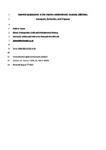Foamed Polystyrene in the Marine Environment: Sources, Additives, Transport, Behavior, and Impacts
| dc.contributor.author | Turner, Andrew | |
| dc.date.accessioned | 2020-10-05T12:06:19Z | |
| dc.date.available | 2020-10-05T12:06:19Z | |
| dc.date.issued | 2020-09-01 | |
| dc.identifier.issn | 0013-936X | |
| dc.identifier.issn | 1520-5851 | |
| dc.identifier.uri | http://hdl.handle.net/10026.1/16477 | |
| dc.description.abstract |
Foamed polystyrene (PS) that may be either expanded (EPS) or extruded (XPS) is a rigid, lightweight insulating thermoplastic that has a variety of uses in the consumer, packaging, construction, and marine sectors. The properties of the material also result in waste that is readily generated, dispersed, and fragmented in the environment. This review focuses on foamed PS in the marine setting, including its sources, transport, degradation, acquisition of contaminants, ingestion by animals, and biological impacts arising from the mobilization of chemical additives. In the ocean, foamed PS is subject to wind-assisted transport and fracturing via photolytic degradation. The material may also act as a substrate for rafting organisms while being exposed to elevated concentrations of natural and anthropogenic surface-active chemicals in the sea surface microlayer. In the littoral setting, fragmentation is accentuated by milling in the swash zone and abrasion when beached, with wind transport leading to the temporary burial of significant quantities of material. Ingestion of EPS and XPS has been documented for a variety of marine animals, but principally those that feed at the sea surface or use the material as a habitat. As well as risking injuries due to gastro-intestinal blockage, ingestion of foamed PS exposes animals to harmful chemicals, and of greatest concern in this respect is the presence of the historical, but still recycled, flame-retardant, hexabromocyclododecane. Because foamed PS is particularly difficult to retrieve as a constituent of marine litter, means of reducing its presence and impacts will rely on the elimination of processes that generate foamed waste, modification of current storage and disposal practices, and the development of more durable and sustainable alternatives. | |
| dc.format.extent | 10411-10420 | |
| dc.format.medium | Print-Electronic | |
| dc.language | en | |
| dc.language.iso | en | |
| dc.publisher | American Chemical Society (ACS) | |
| dc.subject | Animals | |
| dc.subject | Ecosystem | |
| dc.subject | Environmental Monitoring | |
| dc.subject | Flame Retardants | |
| dc.subject | Plastics | |
| dc.subject | Polystyrenes | |
| dc.subject | Recycling | |
| dc.title | Foamed Polystyrene in the Marine Environment: Sources, Additives, Transport, Behavior, and Impacts | |
| dc.type | journal-article | |
| dc.type | Journal Article | |
| dc.type | Review | |
| plymouth.author-url | https://www.webofscience.com/api/gateway?GWVersion=2&SrcApp=PARTNER_APP&SrcAuth=LinksAMR&KeyUT=WOS:000568649900003&DestLinkType=FullRecord&DestApp=ALL_WOS&UsrCustomerID=11bb513d99f797142bcfeffcc58ea008 | |
| plymouth.issue | 17 | |
| plymouth.volume | 54 | |
| plymouth.publication-status | Published | |
| plymouth.journal | Environmental Science & Technology | |
| dc.identifier.doi | 10.1021/acs.est.0c03221 | |
| plymouth.organisational-group | /Plymouth | |
| plymouth.organisational-group | /Plymouth/Faculty of Science and Engineering | |
| plymouth.organisational-group | /Plymouth/Faculty of Science and Engineering/School of Geography, Earth and Environmental Sciences | |
| plymouth.organisational-group | /Plymouth/REF 2021 Researchers by UoA | |
| plymouth.organisational-group | /Plymouth/REF 2021 Researchers by UoA/UoA07 Earth Systems and Environmental Sciences | |
| plymouth.organisational-group | /Plymouth/Research Groups | |
| plymouth.organisational-group | /Plymouth/Research Groups/BEACh | |
| plymouth.organisational-group | /Plymouth/Research Groups/Marine Institute | |
| plymouth.organisational-group | /Plymouth/Users by role | |
| plymouth.organisational-group | /Plymouth/Users by role/Academics | |
| dc.publisher.place | United States | |
| dcterms.dateAccepted | 2020-08-05 | |
| dc.rights.embargodate | 2021-8-5 | |
| dc.identifier.eissn | 1520-5851 | |
| dc.rights.embargoperiod | Not known | |
| rioxxterms.versionofrecord | 10.1021/acs.est.0c03221 | |
| rioxxterms.licenseref.uri | http://www.rioxx.net/licenses/all-rights-reserved | |
| rioxxterms.licenseref.startdate | 2020-09-01 | |
| rioxxterms.type | Journal Article/Review |


